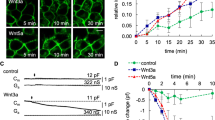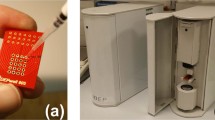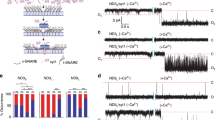Abstract
In order to understand exocytosis and endocytosis, it is necessary to study these processes directly. An elegant way to do this is by measuring plasma membrane capacitance (Cm), a parameter proportional to cell surface area, the fluctuations of which are due to fusion and fission of secretory and other vesicles. Here we describe protocols that enable high-resolution Cm measurements in macroscopic and microscopic modes. Macroscopic mode, performed in whole-cell configuration, is used for measuring bulk Cm changes in the entire membrane area, and it enables the introduction of exocytosis stimulators or inhibitors into the cytosol through the patch pipette. Microscopic mode, performed in cell-attached configuration, enables measurements of Cm with attofarad resolution and allows characterization of fusion pore properties. Although we usually apply these protocols to primary pituitary cells and astrocytes, they can be adapted and used for other cell types. After initial hardware setup and culture preparation, several Cm measurements can be performed daily.
This is a preview of subscription content, access via your institution
Access options
Subscribe to this journal
Receive 12 print issues and online access
$259.00 per year
only $21.58 per issue
Buy this article
- Purchase on Springer Link
- Instant access to full article PDF
Prices may be subject to local taxes which are calculated during checkout



Similar content being viewed by others
References
Grant, B.D. & Donaldson, J.G. Pathways and mechanisms of endocytic recycling. Nat. Rev. Mol. Cell Biol. 10, 597–608 (2009).
Schweizer, F.E. & Ryan, T.A. The synaptic vesicle: cycle of exocytosis and endocytosis. Curr. Opin. Neurobiol. 16, 298–304 (2006).
Rituper, B., Davletov, B. & Zorec, R. Lipid-protein interactions in exocytotic release of hormones and neurotransmitters. Clin. Lipidol. 5, 747–761 (2010).
Katz, B. The Release of Neural Transmitter Substances (Liverpool University Press, 1969).
Neher, E. & Sakmann, B. Single-channel currents recorded from membrane of denervated frog muscle fibres. Nature 260, 799–802 (1976).
Hamill, O.P., Marty, A., Neher, E., Sakmann, B. & Sigworth, F.J. Improved patch-clamp techniques for high-resolution current recording from cells and cell-free membrane patches. Pflugers Arch. 391, 85–100 (1981).
Neher, E. & Marty, A. Discrete changes of cell membrane capacitance observed under conditions of enhanced secretion in bovine adrenal chromaffin cells. Proc. Natl. Acad. Sci. USA 79, 6712–6716 (1982).
Zorec, R., Henigman, F., Mason, W. & Kordaš, M. Electrophysiological study of hormone secretion by single adenohypophyseal cells. Methods Neurosci. 4, 194–210 (1991).
Lledo, P., Vernier, P., Vincent, J., Mason, W. & Zorec, R. Inhibition of Rab3B expression attenuates Ca2+-dependent exocytosis in rat anterior pituitary cells. Nature 364, 540–544 (1993).
Stenovec, M., Kreft, M., Poberaj, I., Betz, W. & Zorec, R. Slow spontaneous secretion from single large dense-core vesicles monitored in neuroendocrine cells. FASEB J. 18, 1270–1272 (2004).
Lindau, M. High-resolution electrophysiological techniques for the study of calcium-activated exocytosis. Biochim. Biophys. Acta 1820, 1234–1242 (2011).
Zorec, R., Sikdar, S. & Mason, W. Increased cytosolic calcium stimulates exocytosis in bovine lactotrophs. Direct evidence from changes in membrane capacitance. J. Gen. Physiol. 97, 473–497 (1991).
Sikdar, S.K., Zorec, R., Brown, D. & Mason, W.T. Dual effects of G-protein activation on Ca-dependent exocytosis in bovine lactotrophs. FEBS Lett. 253, 88–92 (1989).
Sikdar, S.K., Zorec, R. & Mason, W.T. cAMP directly facilitates Ca-induced exocytosis in bovine lactotrophs. FEBS Lett. 273, 150–154 (1990).
Rupnik, M. & Zorec, R. Cytosolic chloride ions stimulate Ca2+-induced exocytosis in melanotrophs. FEBS Lett. 303, 221–223 (1992).
Rupnik, M. et al. Increased cytosolic chloride affects depolarization-induced changes in membrane capacitance and cytosolic calcium activity in rat melanotrophs. Ann. N Y Acad. Sci. 710, 319–327 (1994).
Ellis-Davies, G.C. & Kaplan, J.H. Nitrophenyl-EGTA, a photolabile chelator that selectively binds Ca2+ with high affinity and releases it rapidly upon photolysis. Proc. Natl. Acad. Sci. USA 91, 187–191 (1994).
Thomas, P., Wong, J.G. & Almers, W. Millisecond studies of secretion in single rat pituitary cells stimulated by flash photolysis of caged Ca2+. EMBO J. 12, 303–306 (1993).
Thomas, P., Wong, J.G., Lee, A.K. & Almers, W. A low affinity Ca2+ receptor controls the final steps in peptide secretion from pituitary melanotrophs. Neuron 11, 93–104 (1993).
Kreft, M. et al. The heterotrimeric Gi3 protein acts in slow but not in fast exocytosis of rat melanotrophs. J. Cell Sci. 112 (Pt 22): 4143–4150 (1999).
Rupnik, M. et al. Rapid regulated dense-core vesicle exocytosis requires the CAPS protein. Proc. Natl. Acad. Sci. USA 97, 5627–5632 (2000).
Kreft, M. et al. Synaptotagmin I increases the probability of vesicle fusion at low [Ca2+] in pituitary cells. Am. J. Physiol. Cell Physiol. 284, C547–C554 (2003).
Rupnik, M. et al. Distinct role of Rab3A and Rab3B in secretory activity of rat melanotrophs. Am. J. Physiol. Cell Physiol. 292, C98–C105 (2007).
Coorssen, J.R., Schmitt, H. & Almers, W. Ca2+ triggers massive exocytosis in Chinese hamster ovary cells. EMBO J. 15, 3787–3791 (1996).
Parsons, T.D., Coorssen, J.R., Horstmann, H. & Almers, W. Docked granules, the exocytic burst, and the need for ATP hydrolysis in endocrine cells. Neuron 15, 1085–1096 (1995).
Sikdar, S.K., Kreft, M. & Zorec, R. Modulation of the unitary exocytic event amplitude by cAMP in rat melanotrophs. J. Physiol. 511 (Pt 3): 851–859 (1998).
Darios, F. et al. Sphingosine facilitates SNARE complex assembly and activates synaptic vesicle exocytosis. Neuron 62, 683–694 (2009).
Zupancic, G. et al. The separation of exocytosis from endocytosis in rat melanotroph membrane capacitance records. J. Physiol. 480 (Pt 3): 539–552 (1994).
Fernandez, J.M., Neher, E. & Gomperts, B.D. Capacitance measurements reveal stepwise fusion events in degranulating mast cells. Nature 312, 453–455 (1984).
Breckenridge, L.J. & Almers, W. Currents through the fusion pore that forms during exocytosis of a secretory vesicle. Nature 328, 814–817 (1987).
Zimmerberg, J., Curran, M., Cohen, F.S. & Brodwick, M. Simultaneous electrical and optical measurements show that membrane fusion precedes secretory granule swelling during exocytosis of beige mouse mast cells. Proc. Natl. Acad. Sci. USA 84, 1585–1589 (1987).
Alvarez de Toledo, G. & Fernandez, J.M. The events leading to secretory granule fusion. Soc. Gen. Physiol. Ser. 43, 333–344 (1988).
Monck, J.R., Alvarez de Toledo, G. & Fernandez, J.M. Tension in secretory granule membranes causes extensive membrane transfer through the exocytotic fusion pore. Proc. Natl. Acad. Sci. USA 87, 7804–7808 (1990).
Spruce, A.E., Breckenridge, L.J., Lee, A.K. & Almers, W. Properties of the fusion pore that forms during exocytosis of a mast cell secretory vesicle. Neuron 4, 643–654 (1990).
Oberhauser, A.F. & Fernandez, J.M. Hydrophobic ions amplify the capacitive currents used to measure exocytotic fusion. Biophys. J. 69, 451–459 (1995).
Albillos, A. et al. The exocytotic event in chromaffin cells revealed by patch amperometry. Nature 389, 509–512 (1997).
Kreft, M. & Zorec, R. Cell-attached measurements of attofarad capacitance steps in rat melanotrophs. Pflugers Arch. 434, 212–214 (1997).
Klyachko, V.A. & Jackson, M.B. Capacitance steps and fusion pores of small and large-dense-core vesicles in nerve terminals. Nature 418, 89–92 (2002).
Vardjan, N., Stenovec, M., Jorgacevski, J., Kreft, M. & Zorec, R. Subnanometer fusion pores in spontaneous exocytosis of peptidergic vesicles. J. Neurosci. 27, 4737–4746 (2007).
Jorgacevski, J. et al. Hypotonicity and peptide discharge from a single vesicle. Am. J. Physiol. Cell Physiol. 295, C624–C631 (2008).
Jorgacevski, J. et al. Fusion pore stability of peptidergic vesicles. Mol. Membr. Biol. 27, 65–80 (2010).
Jorgacevski, J. et al. Munc18-1 tuning of vesicle merger and fusion pore properties. J. Neurosci. 31, 9055–9066 (2011).
Debus, K. & Lindau, M. Resolution of patch capacitance recordings and of fusion pore conductances in small vesicles. Biophys. J. 78, 2983–2997 (2000).
Calejo, A.I. et al. Aluminium-induced changes of fusion pore properties attenuate prolactin secretion in rat pituitary lactotrophs. Neuroscience 201, 57–66 (2012).
Rituper, B., Flasker, A., Gucek, A., Chowdhury, H.H. & Zorec, R. Cholesterol and regulated exocytosis: a requirement for unitary exocytotic events. Cell Calcium 52, 250–258 (2012).
Tester, M. & Zorec, R. Cytoplasmic calcium stimulates exocytosis in a plant secretory cell. Biophys. J. 63, 864–867 (1992).
Zorec, R. & Tester, M. Rapid pressure driven exocytosis-endocytosis cycle in a single plant cell. Capacitance measurements in aleurone protoplasts. FEBS Lett. 333, 283–286 (1993).
Thiel, G., Kreft, M. & Zorec, R. Rhythmic kinetics of single fusion and fission in a plant cell protoplast. Ann. N Y Acad. Sci. 1152, 1–6 (2009).
Bandmann, V., Kreft, M. & Homann, U. Modes of exocytotic and endocytotic events in tobacco BY-2 protoplasts. Mol. Plant 4, 241–251 (2011).
Weise, R., Kreft, M., Zorec, R., Homann, U. & Thiel, G. Transient and permanent fusion of vesicles in Zea mays coleoptile protoplasts measured in the cell-attached configuration. J. Membr. Biol. 174, 15–20 (2000).
Zhang, Q. et al. Fusion-related release of glutamate from astrocytes. J. Biol. Chem. 279, 12724–12733 (2004).
Pangrsic, T. et al. Exocytotic release of ATP from cultured astrocytes. J. Biol. Chem. 282, 28749–28758 (2007).
Moser, T. & Beutner, D. Kinetics of exocytosis and endocytosis at the cochlear inner hair cell afferent synapse of the mouse. Proc. Natl. Acad. Sci. USA 97, 883–888 (2000).
Chowdhury, H.H., Kreft, M. & Zorec, R. Rapid insulin-induced exocytosis in white rat adipocytes. Pflugers Arch. 445, 352–356 (2002).
Graf, J., Rupnik, M., Zupancic, G. & Zorec, R. Osmotic swelling of hepatocytes increases membrane conductance but not membrane capacitance. Biophys. J. 68, 1359–1363 (1995).
Kreft, M., Krizaj, D., Grilc, S. & Zorec, R. Properties of exocytotic response in vertebrate photoreceptors. J. Neurophysiol. 90, 218–225 (2003).
Vandenbeuch, A., Zorec, R. & Kinnamon, S.C. Capacitance measurements of regulated exocytosis in mouse taste cells. J. Neurosci. 30, 14695–14701.
Wightman, R.M. et al. Temporally resolved catecholamine spikes correspond to single vesicle release from individual chromaffin cells. Proc. Natl. Acad. Sci. USA 88, 10754–10758 (1991).
Alvarez de Toledo, G., Fernández-Chacón, R. & Fernández, J.M. Release of secretory products during transient vesicle fusion. Nature 363, 554–558 (1993).
Betz, W.J., Mao, F. & Bewick, G.S. Activity-dependent fluorescent staining and destaining of living vertebrate motor nerve terminals. J. Neurosci. 12, 363–375 (1992).
Stenovec, M., Poberaj, I., Kreft, M. & Zorec, R. Concentration-dependent staining of lactotroph vesicles by FM 4-64. Biophys. J. 88, 2607–2613 (2005).
Miesenböck, G., De Angelis, D.A. & Rothman, J.E. Visualizing secretion and synaptic transmission with pH-sensitive green fluorescent proteins. Nature 394, 192–195 (1998).
Malarkey, E.B. & Parpura, V. Temporal characteristics of vesicular fusion in astrocytes: examination of synaptobrevin 2-laden vesicles at single vesicle resolution. J. Physiol. 589, 4271–4300 (2011).
Helmchen, F. & Denk, W. Deep tissue two-photon microscopy. Nat. Methods 2, 932–940 (2005).
Speidel, D. et al. CAPS1 regulates catecholamine loading of large dense-core vesicles. Neuron 46, 75–88 (2005).
Neef, A., Heinemann, C. & Moser, T. Measurements of membrane patch capacitance using a software-based lock-in system. Pflugers Arch. 454, 335–344 (2007).
Lindau, M. & Neher, E. Patch-clamp techniques for time-resolved capacitance measurements in single cells. Pflugers Arch. 411, 137–146 (1988).
Gillis, K.D. Techniques for membrane capacitance measurements. in Single-Channel Recording (eds. Sakmann, B. & Neher, E.) 155–198 (Plenum Press, 1995).
Rae, J., Cooper, K., Gates, P. & Watsky, M. Low access resistance perforated patch recordings using amphotericin B. J. Neurosci. Methods 37, 15–26 (1991).
Horn, R. & Marty, A. Muscarinic activation of ionic currents measured by a new whole-cell recording method. J. Gen. Physiol. 92, 145–159 (1988).
Lippiat, J.D. Whole-cell recording using the perforated patch clamp technique. Methods Mol. Biol. 491, 141–149 (2008).
Horrigan, F.T. & Bookman, R.J. Releasable pools and the kinetics of exocytosis in adrenal chromaffin cells. Neuron 13, 1119–1129 (1994).
Sakmann, B. & Neher, E. Single-Channel Recording (Plenum Press, 1995).
Heinemann, S. Guide to data acquisition and analysis. in Single-Channel Recording (eds. Sakmann, B. & Neher, E.) 53–91 (Plenum Press, 1995).
Poberaj, I., Rupnik, M., Kreft, M., Sikdar, S.K. & Zorec, R. Modeling excess retrieval in rat melanotroph membrane capacitance records. Biophys. J. 82, 226–232 (2002).
Ben-Tabou, S., Keller, E. & Nussinovitch, I. Mechanosensitivity of voltage-gated calcium currents in rat anterior pituitary cells. J. Physiol. 476, 29–39 (1994).
Mitchner, N.A., Garlick, C. & Ben-Jonathan, N. Cellular distribution and gene regulation of estrogen receptors-α and -β in the rat pituitary gland. Endocrinology 139, 3976–3983 (1998).
Rupnik, M. & Zorec, R. Intracellular Cl− modulates Ca2+-induced exocytosis from rat melanotrophs through GTP-binding proteins. Pflugers Arch. 431, 76–83 (1995).
Lindau, M. Time-resolved capacitance measurements: monitoring exocytosis in single cells. Q. Rev. Biophys. 24, 75–101 (1991).
Rituper, B. et al. Cholesterol-mediated membrane surface area dynamics in neuroendocrine cells. Biochim. Biophys. Acta 1831, 1228–1238 (2013).
Schiavo, G., Matteoli, M. & Montecucco, C. Neurotoxins affecting neuroexocytosis. Physiol. Rev. 80, 717–766 (2000).
Harper, C.B. et al. Dynamin inhibition blocks botulinum neurotoxin type A endocytosis in neurons and delays botulism. J. Biol. Chem. 286, 35966–35976 (2011).
Macia, E. et al. Dynasore, a cell-permeable inhibitor of dynamin. Dev. Cell 10, 839–850 (2006).
Pusch, M. & Neher, E. Rates of diffusional exchange between small cells and a measuring patch pipette. Pflugers Arch. 411, 204–211 (1988).
Acknowledgements
This work was supported by the Slovenian Research Agency under grant no. P3 310 and project nos. J3 4051, J3-4146 and J3-3632. We acknowledge F. Henigman, M. Tester, G. Thiel, H.H. Chowdhury, J. Graf, S. Kinnamon, T. Pangršič, M. Rupnik and G. Zupančič for contributions to the development of the protocol as outlined in the published papers.
Author information
Authors and Affiliations
Contributions
B.R. and A.F. performed the experiments, analyzed the data and prepared the primary melanotroph and lactotroph cultures. B.R. and A.G. prepared the figures. J.J., M.K. and R.Z. developed the protocols for Cm measurements. All authors wrote the paper and discussed the results and implications and commented on the manuscript at all stages.
Corresponding author
Ethics declarations
Competing interests
B.R., A.G., J.J., A.F. and M.K. declare no competing financial interests. R.Z. has an equity interest in Celica Biomedical Center.
Rights and permissions
About this article
Cite this article
Rituper, B., Guček, A., Jorgačevski, J. et al. High-resolution membrane capacitance measurements for the study of exocytosis and endocytosis. Nat Protoc 8, 1169–1183 (2013). https://doi.org/10.1038/nprot.2013.069
Published:
Issue Date:
DOI: https://doi.org/10.1038/nprot.2013.069
This article is cited by
-
Exocytosis of large-diameter lysosomes mediates interferon γ-induced relocation of MHC class II molecules toward the surface of astrocytes
Cellular and Molecular Life Sciences (2020)
-
Astroglial Mechanisms of Ketamine Action Include Reduced Mobility of Kir4.1-Carrying Vesicles
Neurochemical Research (2020)
-
Astrocyte Specific Remodeling of Plasmalemmal Cholesterol Composition by Ketamine Indicates a New Mechanism of Antidepressant Action
Scientific Reports (2019)
-
Membrane capacitance recordings resolve dynamics and complexity of receptor-mediated endocytosis in Wnt signalling
Scientific Reports (2019)
-
Sphingomimetic multiple sclerosis drug FTY720 activates vesicular synaptobrevin and augments neuroendocrine secretion
Scientific Reports (2017)
Comments
By submitting a comment you agree to abide by our Terms and Community Guidelines. If you find something abusive or that does not comply with our terms or guidelines please flag it as inappropriate.



